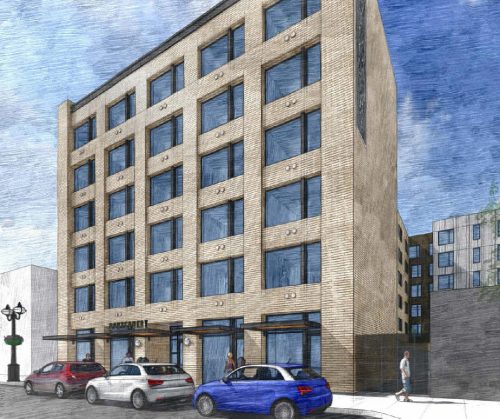
The old, vacant Lane Community College building on Willamette Street might finally have a new destiny — being razed, paving the way for a mixed income apartment building. Both the city and housing advocates acknowledge Eugene needs more housing, but some are questioning the building’s affordability and lackluster design.
The proposed development, located at 1059 Willamette Street across from the downtown LTD station, seeks to serve mixed income households by providing a cheaper rental rate for at least 51 percent of the apartments and the rest at market rate.
The “L” shaped building will be called The Montgomery, as an homage to the Montgomery Ward department store that occupied the building when it was first constructed in the 1930s. It later served as the LCC downtown campus before the Mary Spilde Center was built.
“1059 Willamette has been on this city’s radar for a while,” says Amanda D’Souza, a business development analyst with the city. “Our idea was that the site could be used for fixed income housing.” She says Eugene bought the building in April 2020 with funding support from the Federal Community Block Grant Entitlement Program, a subsidy that supports lower income housing.
D’Souza says the city initially looked into preserving the building, but she says the amount of asbestos and lead poisoning showed it would be more effective to start from the ground up.
There will be 129 units ranging from studio to two-bedrooms, according to the building proposal, with 10 apartments dedicated to Womenspace, an organization that provides shelter and services for survivors of domestic abuse, and space along Willamette Street for retail businesses. The building style appears to be the “Five over one” type construction that has proliferated around Eugene from the new LCC building to 13th and Olive.
To qualify for an affordable housing unit, individuals or households must make 80 percent or less of the area median income, according to data from the Department of Housing and Urban Development (HUD). In 2020, 80 percent of Eugene’s average median income was $39,200 for a single household and $44,800 for a two-person household. If the building was ready for move-in today, individuals making those amounts or less a year would be eligible for the affordable apartments.
Although the city is following HUD’s requirements for calculating rent for those with median incomes, the apartments are still not exactly affordable. The proposed monthly rent for a studio is $894 and the monthly rent for a one bedroom is $956, which includes most utilities. The rest of the rooms priced at market rate span from $1,050 to $2,300, not including utilities.
According to Zumper, a housing rental website that also collects data on average rental rates across the country, the median rental rate for a studio in downtown Eugene is $939 and $1,195 for a one bedroom apartment.
Tim Morris, executive director of the Springfield-Eugene Tenant Association, says overall the building is a good investment because the city needs more rental units, but acknowledges that these prices aren’t affordable for those making median incomes.
“I’m really excited to see Eugene take a step toward addressing lower income units near transit lines. But I share concerns that it’s not addressing the systemic issue of affordability,” Morris says. “I cringe anytime I hear ‘affordable housing’ because that really means nothing.”
Morris says he wants to see the city not just hit a checkmark on lower income requirements, but really invest in the lower income community.
“It’s really burdensome when I hear these are ‘affordable houses’ but aren’t really addressing the issues,” Morris says.
He explains that a survey conducted by the Springfield-Eugene Tenant Association in 2019 found that one of the top issues was high cost of rent, which is still true today. Not only are rental rates really high, Morris says, but people struggle with upfront costs that, for example, may include paying a large security deposit as well as first month’s rent.
In addressing the unaffordability aspect, Morris says small local changes or ordinances can have a large impact. For example, having rentals be first come first serve, and lowering upfront costs. Overall, he hopes that some of the empty space downtown can be utilized for these purposes.
“I’m excited for some of the abandoned, empty lots to be looked at with a closer inspection to truly see what we could do to close those gaps,” Morris says.
The new building isn’t necessarily an architectural dream, either, according to Otto Poticha, a local architect and professor at the University of Oregon. He says he agrees with the decision to tear down the former building, but the design for The Montgomery lacks originality as it is a box shape with no distinguishing features.
Poticha says this is a pattern of the city when it comes to constructing new buildings.
“Eugene is not particular about what gets built. They are so eager to get something done that they will approve anything,” he says.
Subsidizing buildings is the way cities “make things happen,” Poticha explains. He says the developers don’t care about affordable housing, just the money involved.
“The history of architecture in downtown is that the use of the building has always reflected itself on the outside,” Poticha says. “But this thing is like a piece of pasta, it comes out of the roller and there it is.”
He encourages the city to advocate for better designed buildings. He recalls that years ago, Eugene’s Urban Renewal Board had separate, appointed people in charge of making these decisions. But then the Eugene City Council became the Urban Renewal Board.
“Politics, planning and design have nothing to do with each other at all,” Poticha says.
The Eugene City Council will discuss the project during an April 28 work session. The city sought feedback from the community in a comment period that ended April 9.